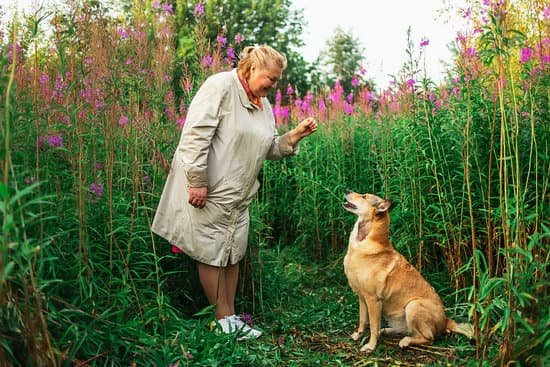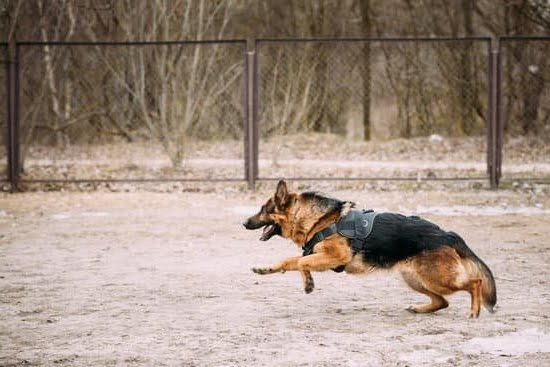Training your dog to walk without a leash can be an enjoyable and rewarding experience for both you and your furry companion. Many pet owners aspire to have the freedom of walking their dogs off-leash, allowing them to explore their surroundings more freely. However, achieving this level of trust and obedience requires patience, consistency, and proper training techniques.
Walking your dog without a leash provides numerous benefits beyond just the sense of freedom it offers. By allowing your dog to walk off-leash, you are giving them the opportunity to engage in natural behaviors like sniffing, running, and exploring their environment more freely. This can lead to increased physical exercise, mental stimulation, and overall happiness for your pup.
In order to successfully train your dog to walk without a leash, it is crucial to first understand your dog’s behavior and body language. Being able to interpret how your dog communicates through subtle cues will help you build a stronger bond and establish trust during off-leash walks. By incorporating basic obedience training techniques and gradually introducing off-leash walking in controlled environments, you can set yourself up for a successful training journey with your furry friend.
Benefits of Walking Your Dog Without a Leash
Walking your dog without a leash can provide numerous benefits for both you and your furry companion. One of the main advantages is the freedom it allows your dog to explore and move more naturally, mimicking their instinctual behavior in the wild. Without the constraints of a leash, dogs can have a greater range of motion and be able to sniff, run, and play more freely.
Physical and Mental Stimulation
Off-leash walks also offer greater physical and mental stimulation for your dog. By being off-leash, they can engage in activities like running, chasing after birds or squirrels, and playing with other dogs. This increased physical activity can help maintain their overall health and well-being, preventing issues like obesity or joint problems. Additionally, the mental stimulation from exploring different scents and environments can prevent boredom and alleviate stress or anxiety.
Bonding and Relationship Building
Another benefit of walking your dog without a leash is the opportunity for bonding and relationship building. When your dog learns to walk by your side without being restrained by a leash, it signifies trust between you both.
This shared experience can strengthen the bond you have with your pet as you communicate non-verbally through body language and cues. Additionally, off-leash walks create moments of joy and fun that can enhance the connection between you and your furry friend.
Understanding Your Dog’s Behavior and Body Language
Why Is Understanding Your Dog’s Behavior Important?
Before embarking on the journey of training your dog to walk without a leash, it is crucial to understand your furry companion’s behavior and body language. Dogs communicate largely through body language, and being able to interpret their signals can greatly aid in successful off-leash training. By being attuned to your dog’s cues, you can better predict their reactions and needs during walks.
Interpreting Your Dog’s Body Language
Dogs use various cues to express their emotions and intentions. For instance, a wagging tail does not always indicate happiness – it could signify uncertainty or stress in some situations. Learning how to read subtle signs such as ear position, eye contact, posture, and vocalizations can help you gauge your dog’s comfort level and adjust your training approach accordingly.
Recognizing Behavioral Triggers
It is essential to identify what triggers certain behaviors in your dog. Whether it is encountering other dogs, wildlife, unfamiliar environments, or specific noises, understanding these triggers will assist you in preempting any potential issues during off-leash walks. By recognizing these triggers early on, you can work on desensitizing your dog and building their confidence gradually while off-leash.
Basic Obedience Training to Prepare for Off-Leash Walking
Basic obedience training is an essential foundation for preparing your dog to walk without a leash. Before considering off-leash walking, it is crucial to ensure that your dog understands basic commands such as sit, stay, come, and heel. These commands will form the basis of communication between you and your furry companion when they are exploring without a leash.
Consistent and positive reinforcement is key when training your dog in basic obedience. Using rewards such as treats or verbal praise can help motivate your dog to learn and follow commands effectively. Practice these commands in various environments to help your dog generalize the behaviors and respond reliably regardless of the surroundings.
Additionally, consistency and patience are vital throughout the training process. Dogs thrive on routine and clear expectations, so make sure to set aside time each day for training sessions. By establishing a strong foundation in basic obedience, you are setting both yourself and your four-legged friend up for success when transitioning to off-leash walking. So, how do you train your dog to walk without a leash? It all starts with mastering these fundamental skills.
Gradual Introduction to Off-Leash Walking
When it comes to training your dog to walk without a leash, starting in a controlled environment is key. This allows you to set the stage for success by gradually introducing your furry friend to the concept of walking off-leash in a safe and secure space. Here are some techniques and tips on how to begin this process:
- Start by practicing in a familiar and enclosed area, such as your backyard or a fenced-in dog park. This will help reduce distractions and keep your dog focused on you during the training.
- Use high-value treats or toys to motivate your dog and reinforce good behavior. Rewarding them for staying close by or checking in with you regularly will encourage them to stick by your side when off-leash.
- Practice recall exercises consistently during each training session. Teaching your dog to come when called is essential for their safety when walking off-leash, so make sure they have a strong understanding of this command before venturing into unfamiliar territory.
As you progress with off-leash training, continue to build on these foundational skills in different environments with varying levels of distractions. Remember that consistency, patience, and positive reinforcement are key components of successful off-leash walking.
- Gradually increase the distance between you and your dog while maintaining their focus on you. This will help strengthen their recall abilities and reinforce trust in your bond.
- Practice off-leash walking during different times of the day to expose your dog to various sights, sounds, and smells. This will help desensitize them to distractions they may encounter while out on walks.
By following these gradual introduction techniques and tips for off-leash training, you can help prepare your dog for enjoyable walks where they can roam freely while still listening attentively to your commands. Remember that every dog is unique, so be patient and celebrate small victories along the way as you work towards achieving off-leash walking success.
Techniques and Tips for Off-Leash Training
Training your dog to walk without a leash can be a rewarding experience for both you and your furry friend. However, it requires patience, consistency, and the right techniques. One of the key tips for off-leash training is to start in a controlled environment with minimal distractions. This could be in your backyard or a fenced-off area where your dog can safely explore without the risk of running off.
When beginning off-leash training, it’s important to have a strong recall command in place. This means that your dog should reliably come back to you when called, even when they are off-leash. Practice this command consistently in a safe environment before attempting off-leash walks in more open spaces. Use positive reinforcement such as treats or praise to reward your dog for returning to you promptly.
Another useful technique for off-leash training is to use a long line or training lead as a transitional tool. A long line gives your dog the freedom to roam while still allowing you to maintain control if needed. Start by using the long line during walks in low-distraction areas and gradually increase the distance between you and your dog. This will help build their confidence and responsiveness while off-leash.
| Off-Leash Training Technique | Description |
|---|---|
| Start in Controlled Environment | Begin off-leash training in a safe, fenced-off area with minimal distractions. |
| Use Strong Recall Command | Practice a reliable recall command with positive reinforcement before attempting off-leash walks. |
| Long Line Training | Use a long line as a transitional tool to give your dog freedom while maintaining control. |
Building Trust and Communication With Your Dog
Building a strong bond with your furry friend is essential when it comes to off-leash training. Trust and communication are key elements in ensuring that your dog understands what is expected of them while walking without a leash. Here are some tips on how to build trust and improve communication with your canine companion:
1. Establish a Routine: Dogs thrive on routine, so establishing a consistent schedule for feeding, walking, and training can help build trust. When your dog knows what to expect, they will feel more secure and confident.
2. Use Positive Reinforcement: Rewarding good behavior with treats, praise, or playtime is an effective way to communicate with your dog. Positive reinforcement helps reinforce desired behaviors and strengthens the bond between you and your pet.
3. Practice Active Listening: Pay attention to your dog’s body language and vocal cues to understand their feelings and needs. By actively listening to your pet, you can better respond to their emotions and build a deeper connection.
By incorporating these strategies into your training routine, you can strengthen the bond with your dog and improve communication, making it easier for them to walk off-leash safely.
Remember that building trust takes time and patience, so be consistent in your training efforts and always prioritize positive interactions with your canine companion. With dedication and commitment, you can enjoy the freedom of walking your dog without a leash while maintaining a strong bond based on trust and communication.
Safety Precautions and Tips for Walking Your Dog Off-Leash
Walking your dog off-leash can be a liberating experience for both you and your furry friend, but it comes with its own set of challenges and responsibilities. Prior to allowing your dog to walk without a leash, it is essential to take certain safety precautions to ensure their well-being as well as the safety of others around you.
One important aspect of off-leash walking is to make sure that your dog is under control at all times and will respond to commands promptly.
First and foremost, before embarking on off-leash walks, ensure that your dog has been properly trained in basic obedience commands such as “sit,” “stay,” “come,” and “leave it.” These commands will serve as the foundation for successful off-leash walking by enabling you to effectively communicate with your dog and keep them safe in potentially challenging situations. Regular practice of these commands in a variety of environments will help reinforce their responses and improve their reliability.
Additionally, it is crucial to consider the environment in which you plan to walk your dog off-leash. Choose areas that are safe, secure, and free from distractions that may cause your dog to wander or become agitated.
Stay vigilant and aware of potential dangers such as other animals, busy roads, or unfamiliar terrain that could pose risks to your dog’s safety. By being proactive and prepared, you can create a safe and enjoyable off-leash walking experience for both you and your canine companion.
Troubleshooting Common Challenges in Off-Leash Training
Training your dog to walk without a leash can be a rewarding experience, but it also comes with its own set of challenges. One common challenge that many pet owners face is their dog’s tendency to get easily distracted by other animals, smells, or noises while walking off-leash. To address this issue, it is important to work on building a strong bond and communication with your dog through consistent training and positive reinforcement.
Another common challenge in off-leash training is managing your dog’s prey drive or desire to chase after small animals. This can be especially difficult for breeds with a high prey drive, such as terriers or sighthounds. To overcome this challenge, you can work on redirecting your dog’s focus onto you by using treats or toys as distractions during walks. Additionally, teaching a reliable recall command can help prevent your dog from running off after small creatures.
Additionally, some dogs may exhibit fearful or anxious behavior when walking without a leash, leading them to either retreat or act aggressively towards unfamiliar situations. It is essential to understand your dog’s body language and behavior cues to address these issues effectively. Gradually exposing your dog to new environments and stimuli while providing positive reinforcement can help build their confidence and reduce anxiety during off-leash walks.
Conclusion
In conclusion, learning how to train your dog to walk without a leash can open up a world of freedom and enjoyment for both you and your furry companion. By understanding your dog’s behavior and body language, as well as establishing basic obedience training, you can prepare for successful off-leash walks. Gradually introducing off-leash walking in a controlled environment, using techniques and tips for training, will help build trust and communication between you and your dog.
As you progress in off-leash training, remember to prioritize safety by following precautions such as ensuring your dog is properly trained and under voice control at all times. It is essential to keep potential risks in mind and be prepared for any challenges that may arise during off-leash walks. By troubleshooting common issues and maintaining consistency in training, you can overcome obstacles and enjoy the benefits of walking your dog without a leash.
Ultimately, the bond formed through off-leash training can lead to a deeper connection with your dog while allowing both of you to experience the joys of outdoor exploration together. So take the time to invest in proper training techniques, be patient with the process, and soon enough you’ll find yourselves confidently strolling side by side without the constraint of a leash.
Frequently Asked Questions
Is It Okay to Walk My Dog Without a Leash?
Walking your dog without a leash can be risky and unsafe, both for your pet and for others around you. Even the most well-behaved dog can get distracted or scared, leading them to run off and potentially get lost or injured. It’s always best to keep your dog on a leash while walking them to ensure their safety.
How Do You Teach a Dog to Walk Away?
Teaching a dog to walk away involves patience, consistency, and positive reinforcement. Start by using treats or toys as rewards for walking away from distractions or triggers. With consistent training sessions and plenty of praise, your dog will learn to walk away on command.
What Is the Best Way to Train a Dog Not to Pull on Leash?
The best way to train a dog not to pull on a leash is through positive reinforcement techniques. Instead of punishing your dog for pulling, reward them when they are walking calmly by your side. Use treats, praise, or toys as incentives to encourage good leash manners. Consistency and patience are key in reinforcing this behavior in your furry friend.

Welcome to the blog! I am a professional dog trainer and have been working with dogs for many years. In this blog, I will be discussing various topics related to dog training, including tips, tricks, and advice. I hope you find this information helpful and informative. Thanks for reading!





